Marks & Spencer: Enhancing Employee Engagement through Strategies
VerifiedAdded on 2023/06/18
|9
|2648
|366
Report
AI Summary
This report examines employee engagement within Marks and Spencer, a leading UK clothing and food retailer. It explores the concept and drivers of employee engagement, including resources, purpose, transparency, financial benefits, feedback, co-worker relationships, growth, and brand value. The report analyzes diagnostic tools used to measure employee engagement, such as worker surveys, HR tools, social media, and exit interviews. It also discusses the employee value proposition, encompassing compensation, benefits, career opportunities, work environment, and organizational culture. Furthermore, the report outlines strategies to increase employee engagement levels, including communication, feedback mechanisms, employee empowerment, and investment in wellbeing. The conclusion emphasizes the importance of employee engagement for business success and brand value.
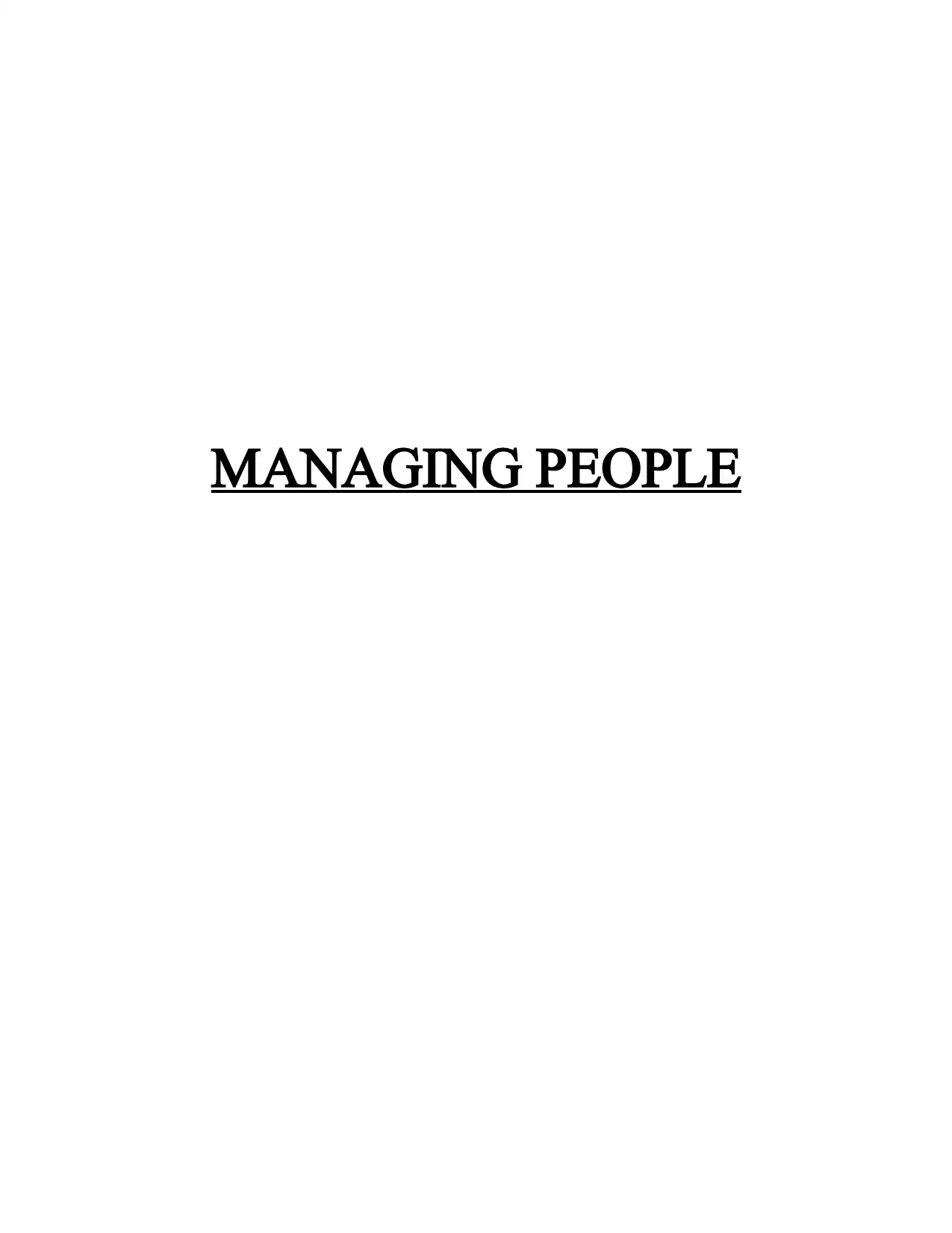
MANAGING PEOPLE
Paraphrase This Document
Need a fresh take? Get an instant paraphrase of this document with our AI Paraphraser
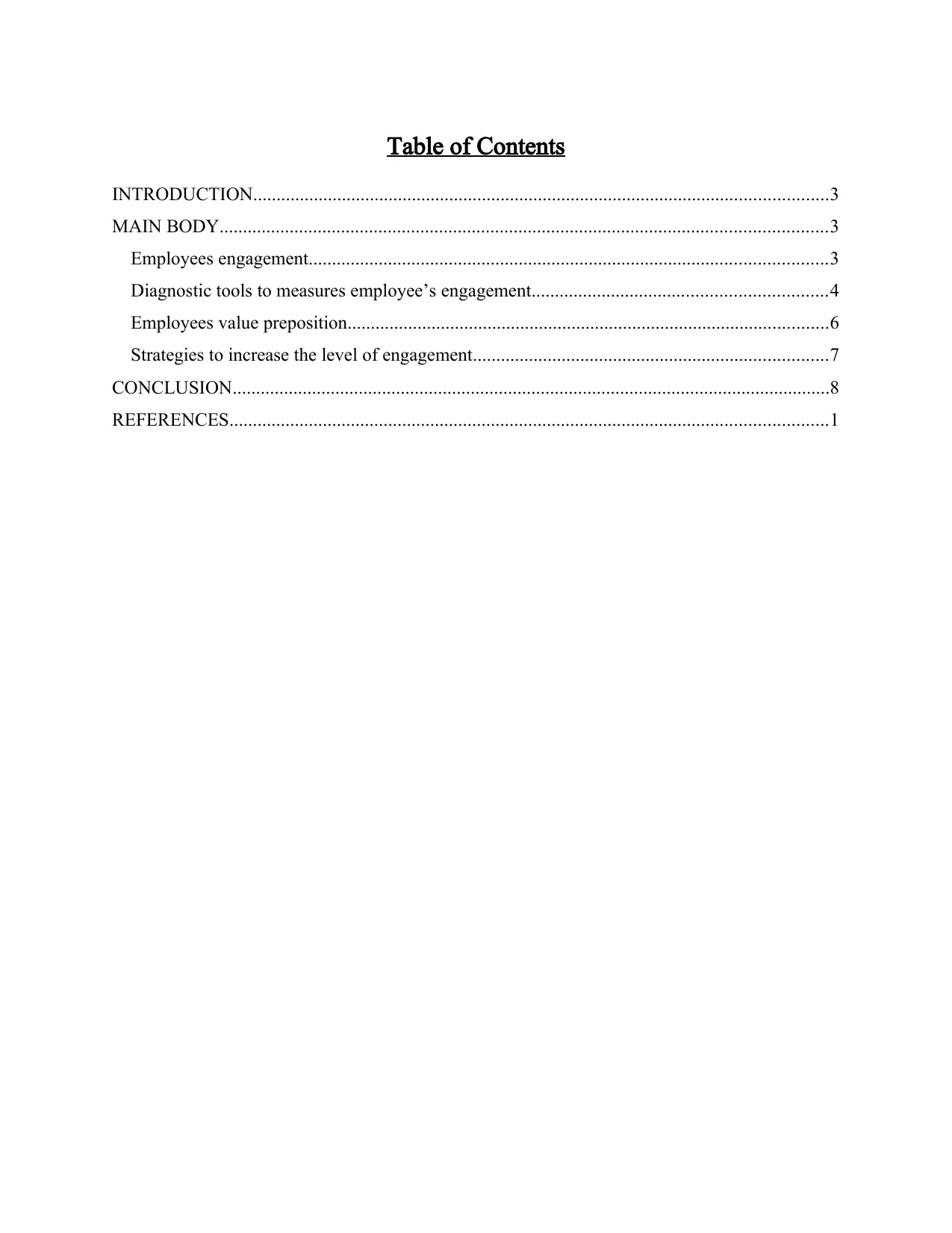
Table of Contents
INTRODUCTION...........................................................................................................................3
MAIN BODY..................................................................................................................................3
Employees engagement...............................................................................................................3
Diagnostic tools to measures employee’s engagement...............................................................4
Employees value preposition.......................................................................................................6
Strategies to increase the level of engagement............................................................................7
CONCLUSION................................................................................................................................8
REFERENCES................................................................................................................................1
INTRODUCTION...........................................................................................................................3
MAIN BODY..................................................................................................................................3
Employees engagement...............................................................................................................3
Diagnostic tools to measures employee’s engagement...............................................................4
Employees value preposition.......................................................................................................6
Strategies to increase the level of engagement............................................................................7
CONCLUSION................................................................................................................................8
REFERENCES................................................................................................................................1

INTRODUCTION
People management refers to the human resources strategy to manage the people of the
organisation in appropriate manner in order to achieve the aim and objectives of the firm. It
provides assistance in improving the performance, behaviour, engagement and job satisfaction of
the employees within the firm (Chemuturi, and Chemuturi, 2019. The present report is based on
the UKs market leading firm of clothing and food organisation named as Marks and Spencer. It
is multinational company which has headquarter in London, England, UK.
The study will highlight the concept and driver of employee’s engagement. Also analysis the
diagnostic tools to measure the engagement of employees. Furthermore, the report will shade a
light on plans of action which is used to raise the levels of engagement.
MAIN BODY
Employees engagement
It is human resources plans of action which determine the level of enthusiasm and devotion of
work by the employees with in firm. It gives assistance in achieving the organisation goal by
passionate employee’s performance. The engaged employees are those who become the best
source of productivity for administration. It assists in increasing the brand value in the
marketplace. In this strategy the workers are fully engaged in their work with the gross amount
of motivation. There are several drivers of employee’s engagement which is bifurcate as follow:
Resources and tool- adequate amount of resource available in the organisation help in motivating
the employees to work in effective manner. If the organisation does not have appropriate tools,
then employees got demotivated which because of that employees are unable to complete their
work on time. Productive tools allow employees to connect with the team members and
cooperated with the colleagues in achieving the objectives (Brutus, and Baronian, 2020).
purpose: it is the most essential factor to consider in employee’s engagement. The
employees of the organisation determine purpose of the organization and purpose of
working their rather than generating profit only. Purpose of the organisation give helping
hand to employees in complete fetching themselves in the work.
Transparency- the workers of the organisation engaged in a business when the leaders
and subordinates have clear deal and updated by the vision of the companies. In short the
job role will be cleared for the employees, there will be no manipulations of mind and
scam with them encourage them to work effectively.
People management refers to the human resources strategy to manage the people of the
organisation in appropriate manner in order to achieve the aim and objectives of the firm. It
provides assistance in improving the performance, behaviour, engagement and job satisfaction of
the employees within the firm (Chemuturi, and Chemuturi, 2019. The present report is based on
the UKs market leading firm of clothing and food organisation named as Marks and Spencer. It
is multinational company which has headquarter in London, England, UK.
The study will highlight the concept and driver of employee’s engagement. Also analysis the
diagnostic tools to measure the engagement of employees. Furthermore, the report will shade a
light on plans of action which is used to raise the levels of engagement.
MAIN BODY
Employees engagement
It is human resources plans of action which determine the level of enthusiasm and devotion of
work by the employees with in firm. It gives assistance in achieving the organisation goal by
passionate employee’s performance. The engaged employees are those who become the best
source of productivity for administration. It assists in increasing the brand value in the
marketplace. In this strategy the workers are fully engaged in their work with the gross amount
of motivation. There are several drivers of employee’s engagement which is bifurcate as follow:
Resources and tool- adequate amount of resource available in the organisation help in motivating
the employees to work in effective manner. If the organisation does not have appropriate tools,
then employees got demotivated which because of that employees are unable to complete their
work on time. Productive tools allow employees to connect with the team members and
cooperated with the colleagues in achieving the objectives (Brutus, and Baronian, 2020).
purpose: it is the most essential factor to consider in employee’s engagement. The
employees of the organisation determine purpose of the organization and purpose of
working their rather than generating profit only. Purpose of the organisation give helping
hand to employees in complete fetching themselves in the work.
Transparency- the workers of the organisation engaged in a business when the leaders
and subordinates have clear deal and updated by the vision of the companies. In short the
job role will be cleared for the employees, there will be no manipulations of mind and
scam with them encourage them to work effectively.
⊘ This is a preview!⊘
Do you want full access?
Subscribe today to unlock all pages.

Trusted by 1+ million students worldwide
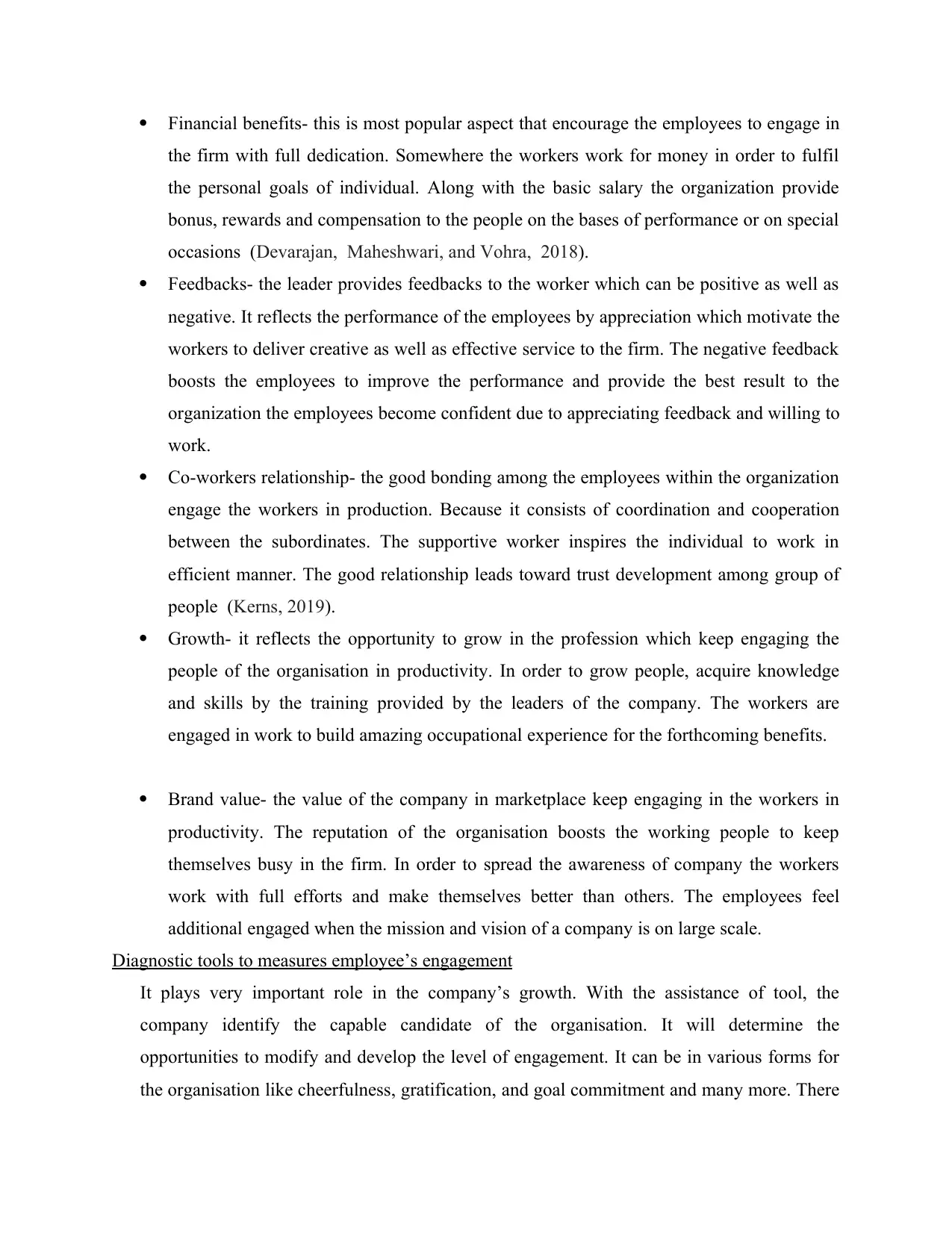
Financial benefits- this is most popular aspect that encourage the employees to engage in
the firm with full dedication. Somewhere the workers work for money in order to fulfil
the personal goals of individual. Along with the basic salary the organization provide
bonus, rewards and compensation to the people on the bases of performance or on special
occasions (Devarajan, Maheshwari, and Vohra, 2018).
Feedbacks- the leader provides feedbacks to the worker which can be positive as well as
negative. It reflects the performance of the employees by appreciation which motivate the
workers to deliver creative as well as effective service to the firm. The negative feedback
boosts the employees to improve the performance and provide the best result to the
organization the employees become confident due to appreciating feedback and willing to
work.
Co-workers relationship- the good bonding among the employees within the organization
engage the workers in production. Because it consists of coordination and cooperation
between the subordinates. The supportive worker inspires the individual to work in
efficient manner. The good relationship leads toward trust development among group of
people (Kerns, 2019).
Growth- it reflects the opportunity to grow in the profession which keep engaging the
people of the organisation in productivity. In order to grow people, acquire knowledge
and skills by the training provided by the leaders of the company. The workers are
engaged in work to build amazing occupational experience for the forthcoming benefits.
Brand value- the value of the company in marketplace keep engaging in the workers in
productivity. The reputation of the organisation boosts the working people to keep
themselves busy in the firm. In order to spread the awareness of company the workers
work with full efforts and make themselves better than others. The employees feel
additional engaged when the mission and vision of a company is on large scale.
Diagnostic tools to measures employee’s engagement
It plays very important role in the company’s growth. With the assistance of tool, the
company identify the capable candidate of the organisation. It will determine the
opportunities to modify and develop the level of engagement. It can be in various forms for
the organisation like cheerfulness, gratification, and goal commitment and many more. There
the firm with full dedication. Somewhere the workers work for money in order to fulfil
the personal goals of individual. Along with the basic salary the organization provide
bonus, rewards and compensation to the people on the bases of performance or on special
occasions (Devarajan, Maheshwari, and Vohra, 2018).
Feedbacks- the leader provides feedbacks to the worker which can be positive as well as
negative. It reflects the performance of the employees by appreciation which motivate the
workers to deliver creative as well as effective service to the firm. The negative feedback
boosts the employees to improve the performance and provide the best result to the
organization the employees become confident due to appreciating feedback and willing to
work.
Co-workers relationship- the good bonding among the employees within the organization
engage the workers in production. Because it consists of coordination and cooperation
between the subordinates. The supportive worker inspires the individual to work in
efficient manner. The good relationship leads toward trust development among group of
people (Kerns, 2019).
Growth- it reflects the opportunity to grow in the profession which keep engaging the
people of the organisation in productivity. In order to grow people, acquire knowledge
and skills by the training provided by the leaders of the company. The workers are
engaged in work to build amazing occupational experience for the forthcoming benefits.
Brand value- the value of the company in marketplace keep engaging in the workers in
productivity. The reputation of the organisation boosts the working people to keep
themselves busy in the firm. In order to spread the awareness of company the workers
work with full efforts and make themselves better than others. The employees feel
additional engaged when the mission and vision of a company is on large scale.
Diagnostic tools to measures employee’s engagement
It plays very important role in the company’s growth. With the assistance of tool, the
company identify the capable candidate of the organisation. It will determine the
opportunities to modify and develop the level of engagement. It can be in various forms for
the organisation like cheerfulness, gratification, and goal commitment and many more. There
Paraphrase This Document
Need a fresh take? Get an instant paraphrase of this document with our AI Paraphraser
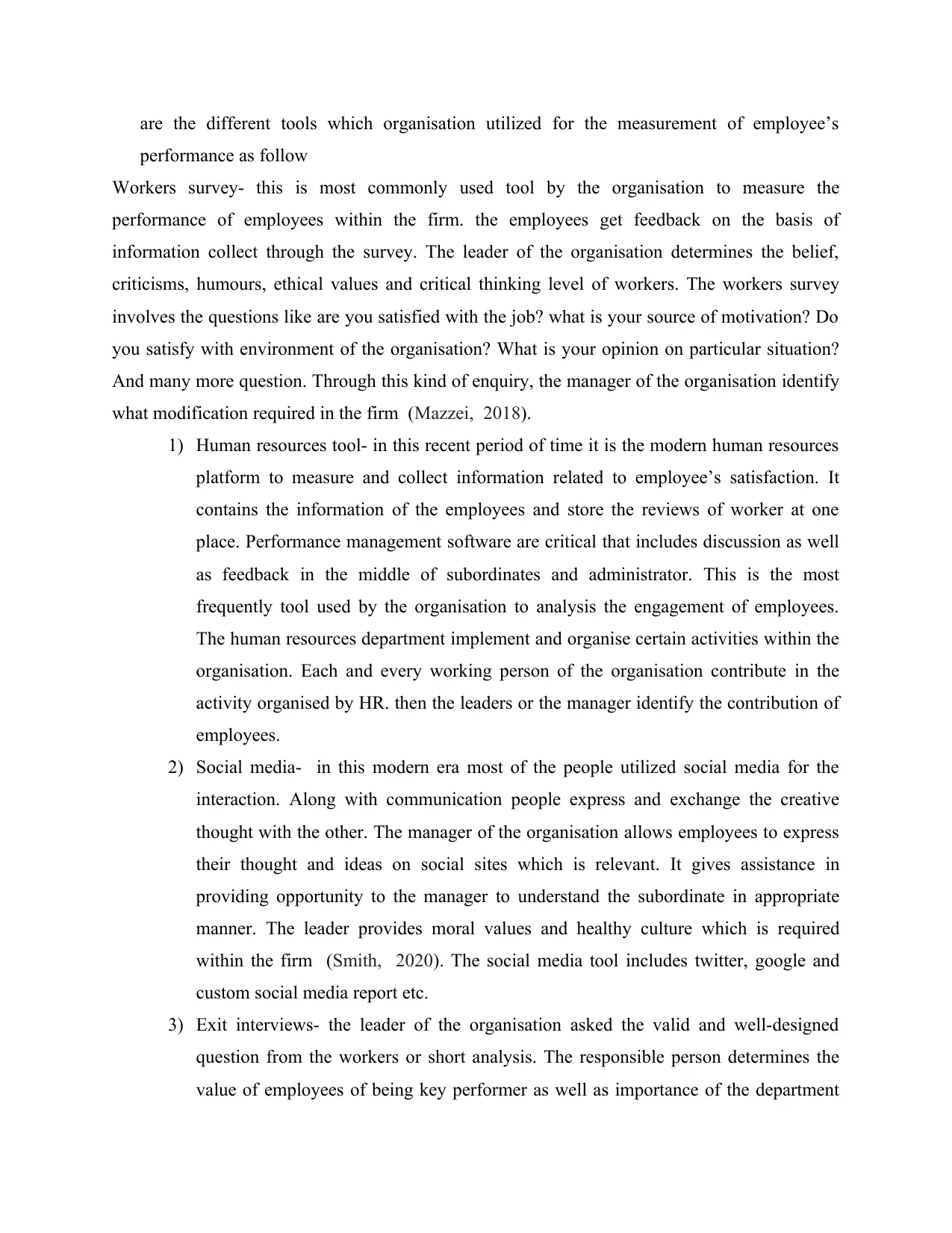
are the different tools which organisation utilized for the measurement of employee’s
performance as follow
Workers survey- this is most commonly used tool by the organisation to measure the
performance of employees within the firm. the employees get feedback on the basis of
information collect through the survey. The leader of the organisation determines the belief,
criticisms, humours, ethical values and critical thinking level of workers. The workers survey
involves the questions like are you satisfied with the job? what is your source of motivation? Do
you satisfy with environment of the organisation? What is your opinion on particular situation?
And many more question. Through this kind of enquiry, the manager of the organisation identify
what modification required in the firm (Mazzei, 2018).
1) Human resources tool- in this recent period of time it is the modern human resources
platform to measure and collect information related to employee’s satisfaction. It
contains the information of the employees and store the reviews of worker at one
place. Performance management software are critical that includes discussion as well
as feedback in the middle of subordinates and administrator. This is the most
frequently tool used by the organisation to analysis the engagement of employees.
The human resources department implement and organise certain activities within the
organisation. Each and every working person of the organisation contribute in the
activity organised by HR. then the leaders or the manager identify the contribution of
employees.
2) Social media- in this modern era most of the people utilized social media for the
interaction. Along with communication people express and exchange the creative
thought with the other. The manager of the organisation allows employees to express
their thought and ideas on social sites which is relevant. It gives assistance in
providing opportunity to the manager to understand the subordinate in appropriate
manner. The leader provides moral values and healthy culture which is required
within the firm (Smith, 2020). The social media tool includes twitter, google and
custom social media report etc.
3) Exit interviews- the leader of the organisation asked the valid and well-designed
question from the workers or short analysis. The responsible person determines the
value of employees of being key performer as well as importance of the department
performance as follow
Workers survey- this is most commonly used tool by the organisation to measure the
performance of employees within the firm. the employees get feedback on the basis of
information collect through the survey. The leader of the organisation determines the belief,
criticisms, humours, ethical values and critical thinking level of workers. The workers survey
involves the questions like are you satisfied with the job? what is your source of motivation? Do
you satisfy with environment of the organisation? What is your opinion on particular situation?
And many more question. Through this kind of enquiry, the manager of the organisation identify
what modification required in the firm (Mazzei, 2018).
1) Human resources tool- in this recent period of time it is the modern human resources
platform to measure and collect information related to employee’s satisfaction. It
contains the information of the employees and store the reviews of worker at one
place. Performance management software are critical that includes discussion as well
as feedback in the middle of subordinates and administrator. This is the most
frequently tool used by the organisation to analysis the engagement of employees.
The human resources department implement and organise certain activities within the
organisation. Each and every working person of the organisation contribute in the
activity organised by HR. then the leaders or the manager identify the contribution of
employees.
2) Social media- in this modern era most of the people utilized social media for the
interaction. Along with communication people express and exchange the creative
thought with the other. The manager of the organisation allows employees to express
their thought and ideas on social sites which is relevant. It gives assistance in
providing opportunity to the manager to understand the subordinate in appropriate
manner. The leader provides moral values and healthy culture which is required
within the firm (Smith, 2020). The social media tool includes twitter, google and
custom social media report etc.
3) Exit interviews- the leader of the organisation asked the valid and well-designed
question from the workers or short analysis. The responsible person determines the
value of employees of being key performer as well as importance of the department
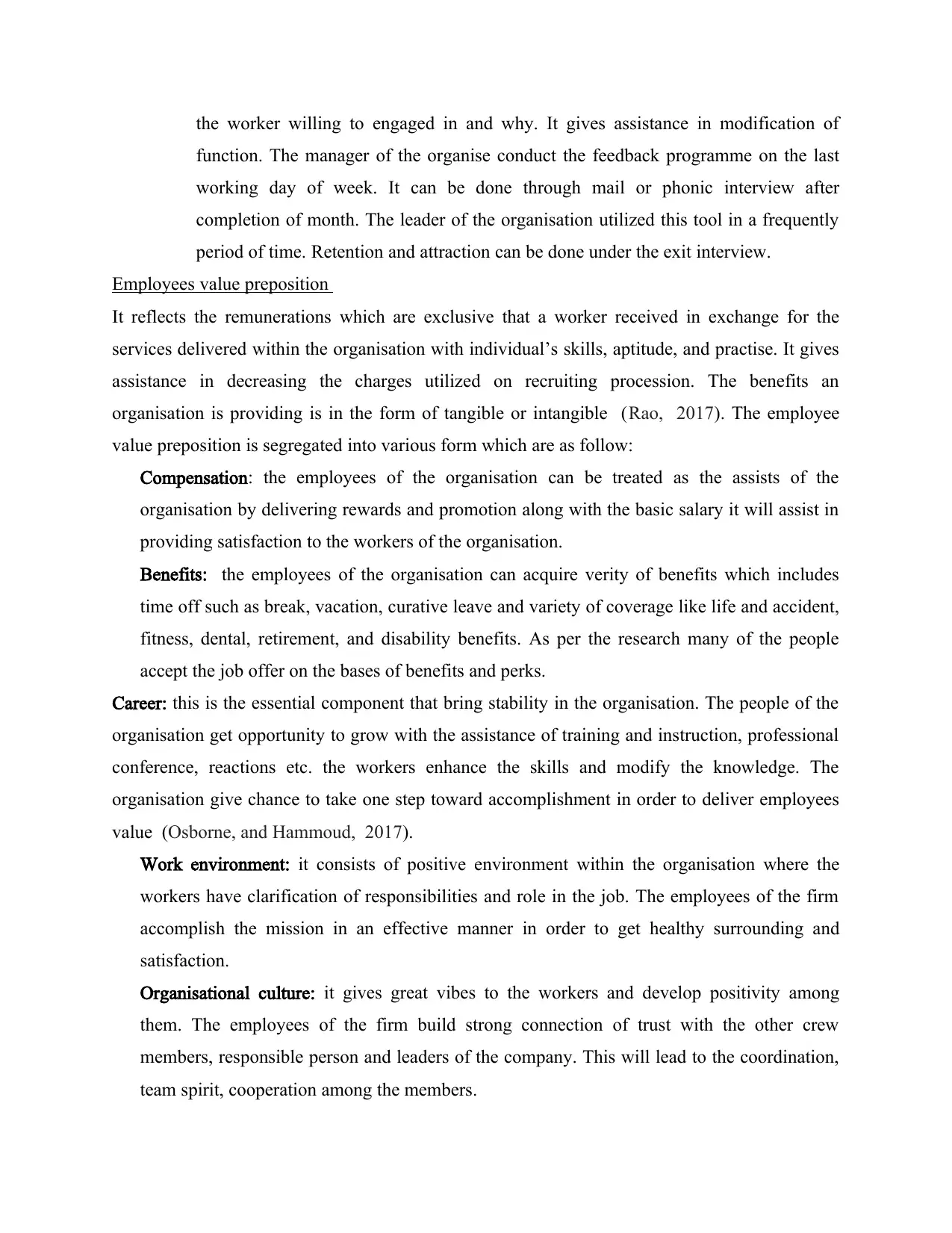
the worker willing to engaged in and why. It gives assistance in modification of
function. The manager of the organise conduct the feedback programme on the last
working day of week. It can be done through mail or phonic interview after
completion of month. The leader of the organisation utilized this tool in a frequently
period of time. Retention and attraction can be done under the exit interview.
Employees value preposition
It reflects the remunerations which are exclusive that a worker received in exchange for the
services delivered within the organisation with individual’s skills, aptitude, and practise. It gives
assistance in decreasing the charges utilized on recruiting procession. The benefits an
organisation is providing is in the form of tangible or intangible (Rao, 2017). The employee
value preposition is segregated into various form which are as follow:
Compensation: the employees of the organisation can be treated as the assists of the
organisation by delivering rewards and promotion along with the basic salary it will assist in
providing satisfaction to the workers of the organisation.
Benefits: the employees of the organisation can acquire verity of benefits which includes
time off such as break, vacation, curative leave and variety of coverage like life and accident,
fitness, dental, retirement, and disability benefits. As per the research many of the people
accept the job offer on the bases of benefits and perks.
Career: this is the essential component that bring stability in the organisation. The people of the
organisation get opportunity to grow with the assistance of training and instruction, professional
conference, reactions etc. the workers enhance the skills and modify the knowledge. The
organisation give chance to take one step toward accomplishment in order to deliver employees
value (Osborne, and Hammoud, 2017).
Work environment: it consists of positive environment within the organisation where the
workers have clarification of responsibilities and role in the job. The employees of the firm
accomplish the mission in an effective manner in order to get healthy surrounding and
satisfaction.
Organisational culture: it gives great vibes to the workers and develop positivity among
them. The employees of the firm build strong connection of trust with the other crew
members, responsible person and leaders of the company. This will lead to the coordination,
team spirit, cooperation among the members.
function. The manager of the organise conduct the feedback programme on the last
working day of week. It can be done through mail or phonic interview after
completion of month. The leader of the organisation utilized this tool in a frequently
period of time. Retention and attraction can be done under the exit interview.
Employees value preposition
It reflects the remunerations which are exclusive that a worker received in exchange for the
services delivered within the organisation with individual’s skills, aptitude, and practise. It gives
assistance in decreasing the charges utilized on recruiting procession. The benefits an
organisation is providing is in the form of tangible or intangible (Rao, 2017). The employee
value preposition is segregated into various form which are as follow:
Compensation: the employees of the organisation can be treated as the assists of the
organisation by delivering rewards and promotion along with the basic salary it will assist in
providing satisfaction to the workers of the organisation.
Benefits: the employees of the organisation can acquire verity of benefits which includes
time off such as break, vacation, curative leave and variety of coverage like life and accident,
fitness, dental, retirement, and disability benefits. As per the research many of the people
accept the job offer on the bases of benefits and perks.
Career: this is the essential component that bring stability in the organisation. The people of the
organisation get opportunity to grow with the assistance of training and instruction, professional
conference, reactions etc. the workers enhance the skills and modify the knowledge. The
organisation give chance to take one step toward accomplishment in order to deliver employees
value (Osborne, and Hammoud, 2017).
Work environment: it consists of positive environment within the organisation where the
workers have clarification of responsibilities and role in the job. The employees of the firm
accomplish the mission in an effective manner in order to get healthy surrounding and
satisfaction.
Organisational culture: it gives great vibes to the workers and develop positivity among
them. The employees of the firm build strong connection of trust with the other crew
members, responsible person and leaders of the company. This will lead to the coordination,
team spirit, cooperation among the members.
⊘ This is a preview!⊘
Do you want full access?
Subscribe today to unlock all pages.

Trusted by 1+ million students worldwide
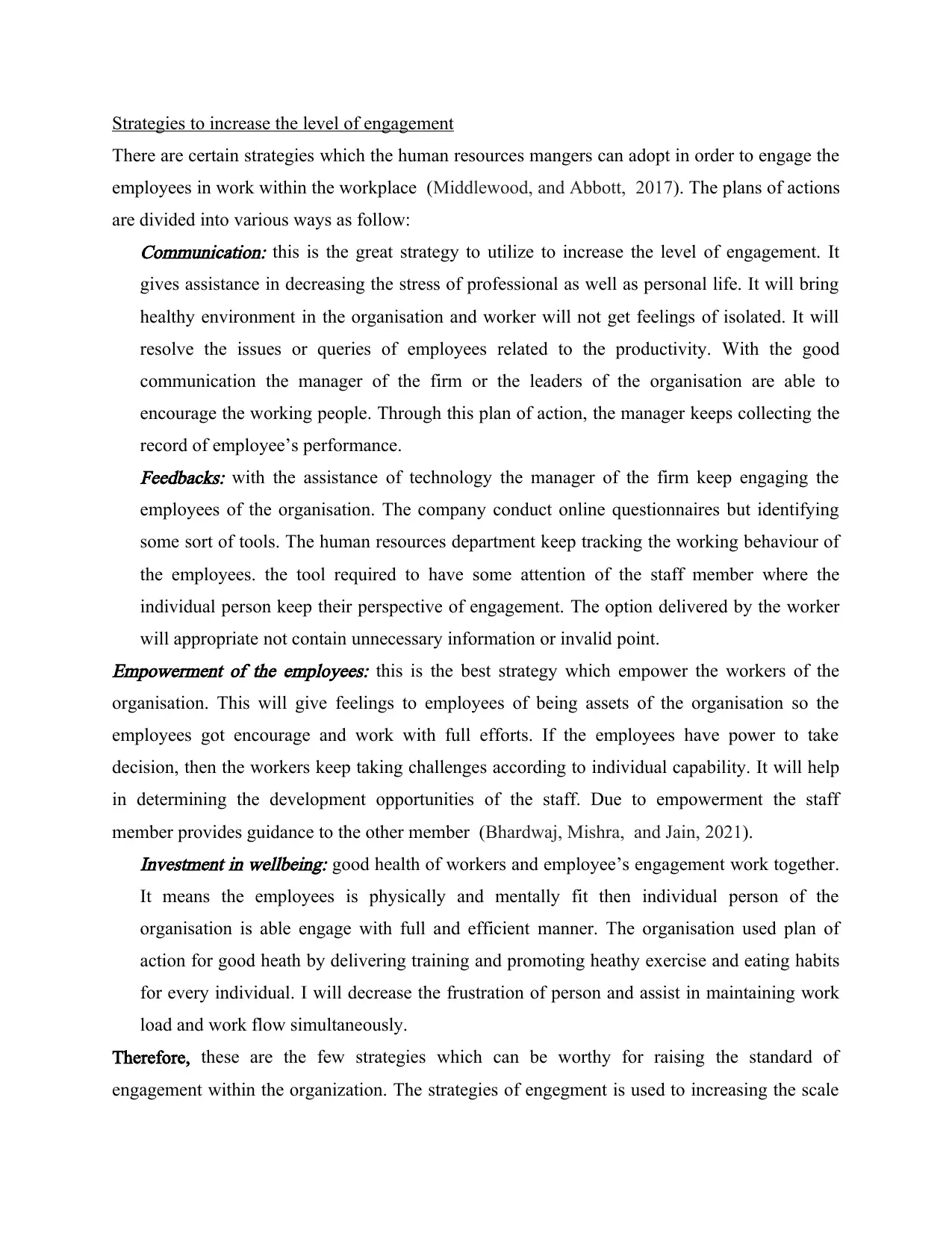
Strategies to increase the level of engagement
There are certain strategies which the human resources mangers can adopt in order to engage the
employees in work within the workplace (Middlewood, and Abbott, 2017). The plans of actions
are divided into various ways as follow:Communication: this is the great strategy to utilize to increase the level of engagement. It
gives assistance in decreasing the stress of professional as well as personal life. It will bring
healthy environment in the organisation and worker will not get feelings of isolated. It will
resolve the issues or queries of employees related to the productivity. With the good
communication the manager of the firm or the leaders of the organisation are able to
encourage the working people. Through this plan of action, the manager keeps collecting the
record of employee’s performance.Feedbacks: with the assistance of technology the manager of the firm keep engaging the
employees of the organisation. The company conduct online questionnaires but identifying
some sort of tools. The human resources department keep tracking the working behaviour of
the employees. the tool required to have some attention of the staff member where the
individual person keep their perspective of engagement. The option delivered by the worker
will appropriate not contain unnecessary information or invalid point.Empowerment of the employees: this is the best strategy which empower the workers of the
organisation. This will give feelings to employees of being assets of the organisation so the
employees got encourage and work with full efforts. If the employees have power to take
decision, then the workers keep taking challenges according to individual capability. It will help
in determining the development opportunities of the staff. Due to empowerment the staff
member provides guidance to the other member (Bhardwaj, Mishra, and Jain, 2021).Investment in wellbeing: good health of workers and employee’s engagement work together.
It means the employees is physically and mentally fit then individual person of the
organisation is able engage with full and efficient manner. The organisation used plan of
action for good heath by delivering training and promoting heathy exercise and eating habits
for every individual. I will decrease the frustration of person and assist in maintaining work
load and work flow simultaneously.
Therefore, these are the few strategies which can be worthy for raising the standard of
engagement within the organization. The strategies of engegment is used to increasing the scale
There are certain strategies which the human resources mangers can adopt in order to engage the
employees in work within the workplace (Middlewood, and Abbott, 2017). The plans of actions
are divided into various ways as follow:Communication: this is the great strategy to utilize to increase the level of engagement. It
gives assistance in decreasing the stress of professional as well as personal life. It will bring
healthy environment in the organisation and worker will not get feelings of isolated. It will
resolve the issues or queries of employees related to the productivity. With the good
communication the manager of the firm or the leaders of the organisation are able to
encourage the working people. Through this plan of action, the manager keeps collecting the
record of employee’s performance.Feedbacks: with the assistance of technology the manager of the firm keep engaging the
employees of the organisation. The company conduct online questionnaires but identifying
some sort of tools. The human resources department keep tracking the working behaviour of
the employees. the tool required to have some attention of the staff member where the
individual person keep their perspective of engagement. The option delivered by the worker
will appropriate not contain unnecessary information or invalid point.Empowerment of the employees: this is the best strategy which empower the workers of the
organisation. This will give feelings to employees of being assets of the organisation so the
employees got encourage and work with full efforts. If the employees have power to take
decision, then the workers keep taking challenges according to individual capability. It will help
in determining the development opportunities of the staff. Due to empowerment the staff
member provides guidance to the other member (Bhardwaj, Mishra, and Jain, 2021).Investment in wellbeing: good health of workers and employee’s engagement work together.
It means the employees is physically and mentally fit then individual person of the
organisation is able engage with full and efficient manner. The organisation used plan of
action for good heath by delivering training and promoting heathy exercise and eating habits
for every individual. I will decrease the frustration of person and assist in maintaining work
load and work flow simultaneously.
Therefore, these are the few strategies which can be worthy for raising the standard of
engagement within the organization. The strategies of engegment is used to increasing the scale
Paraphrase This Document
Need a fresh take? Get an instant paraphrase of this document with our AI Paraphraser
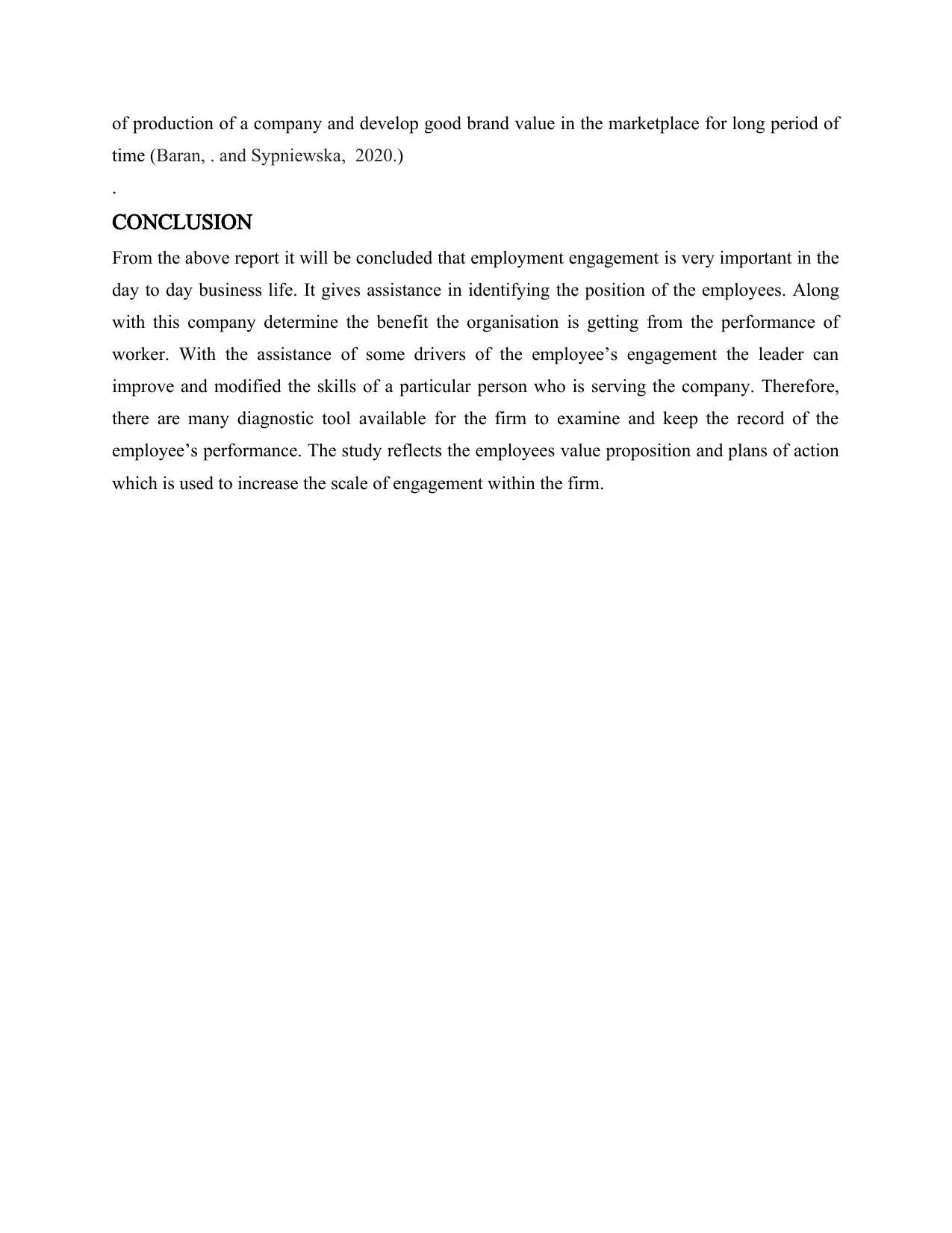
of production of a company and develop good brand value in the marketplace for long period of
time (Baran, . and Sypniewska, 2020.)
.
CONCLUSION
From the above report it will be concluded that employment engagement is very important in the
day to day business life. It gives assistance in identifying the position of the employees. Along
with this company determine the benefit the organisation is getting from the performance of
worker. With the assistance of some drivers of the employee’s engagement the leader can
improve and modified the skills of a particular person who is serving the company. Therefore,
there are many diagnostic tool available for the firm to examine and keep the record of the
employee’s performance. The study reflects the employees value proposition and plans of action
which is used to increase the scale of engagement within the firm.
time (Baran, . and Sypniewska, 2020.)
.
CONCLUSION
From the above report it will be concluded that employment engagement is very important in the
day to day business life. It gives assistance in identifying the position of the employees. Along
with this company determine the benefit the organisation is getting from the performance of
worker. With the assistance of some drivers of the employee’s engagement the leader can
improve and modified the skills of a particular person who is serving the company. Therefore,
there are many diagnostic tool available for the firm to examine and keep the record of the
employee’s performance. The study reflects the employees value proposition and plans of action
which is used to increase the scale of engagement within the firm.
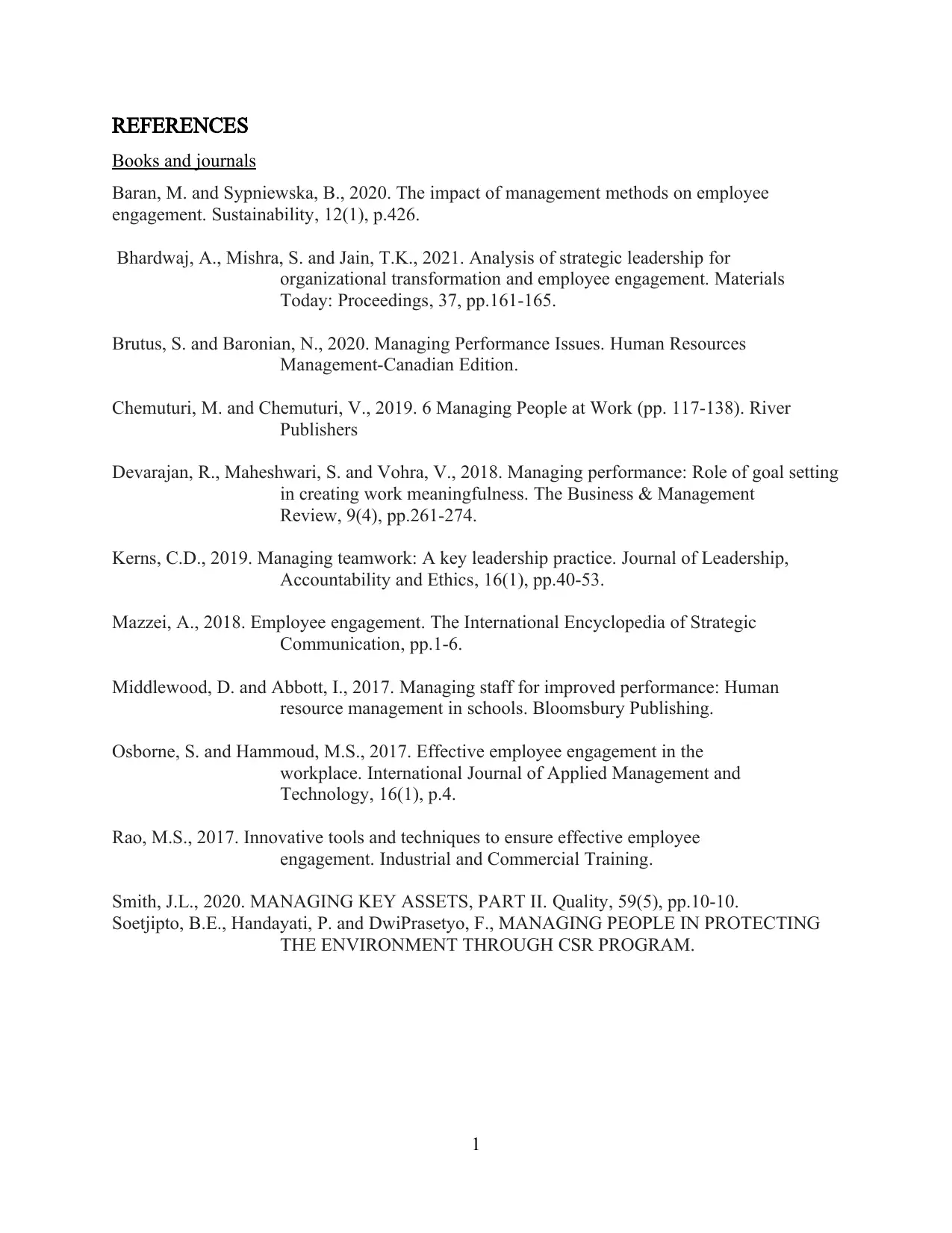
REFERENCES
Books and journals
Baran, M. and Sypniewska, B., 2020. The impact of management methods on employee
engagement. Sustainability, 12(1), p.426.
Bhardwaj, A., Mishra, S. and Jain, T.K., 2021. Analysis of strategic leadership for
organizational transformation and employee engagement. Materials
Today: Proceedings, 37, pp.161-165.
Brutus, S. and Baronian, N., 2020. Managing Performance Issues. Human Resources
Management-Canadian Edition.
Chemuturi, M. and Chemuturi, V., 2019. 6 Managing People at Work (pp. 117-138). River
Publishers
Devarajan, R., Maheshwari, S. and Vohra, V., 2018. Managing performance: Role of goal setting
in creating work meaningfulness. The Business & Management
Review, 9(4), pp.261-274.
Kerns, C.D., 2019. Managing teamwork: A key leadership practice. Journal of Leadership,
Accountability and Ethics, 16(1), pp.40-53.
Mazzei, A., 2018. Employee engagement. The International Encyclopedia of Strategic
Communication, pp.1-6.
Middlewood, D. and Abbott, I., 2017. Managing staff for improved performance: Human
resource management in schools. Bloomsbury Publishing.
Osborne, S. and Hammoud, M.S., 2017. Effective employee engagement in the
workplace. International Journal of Applied Management and
Technology, 16(1), p.4.
Rao, M.S., 2017. Innovative tools and techniques to ensure effective employee
engagement. Industrial and Commercial Training.
Smith, J.L., 2020. MANAGING KEY ASSETS, PART II. Quality, 59(5), pp.10-10.
Soetjipto, B.E., Handayati, P. and DwiPrasetyo, F., MANAGING PEOPLE IN PROTECTING
THE ENVIRONMENT THROUGH CSR PROGRAM.
1
Books and journals
Baran, M. and Sypniewska, B., 2020. The impact of management methods on employee
engagement. Sustainability, 12(1), p.426.
Bhardwaj, A., Mishra, S. and Jain, T.K., 2021. Analysis of strategic leadership for
organizational transformation and employee engagement. Materials
Today: Proceedings, 37, pp.161-165.
Brutus, S. and Baronian, N., 2020. Managing Performance Issues. Human Resources
Management-Canadian Edition.
Chemuturi, M. and Chemuturi, V., 2019. 6 Managing People at Work (pp. 117-138). River
Publishers
Devarajan, R., Maheshwari, S. and Vohra, V., 2018. Managing performance: Role of goal setting
in creating work meaningfulness. The Business & Management
Review, 9(4), pp.261-274.
Kerns, C.D., 2019. Managing teamwork: A key leadership practice. Journal of Leadership,
Accountability and Ethics, 16(1), pp.40-53.
Mazzei, A., 2018. Employee engagement. The International Encyclopedia of Strategic
Communication, pp.1-6.
Middlewood, D. and Abbott, I., 2017. Managing staff for improved performance: Human
resource management in schools. Bloomsbury Publishing.
Osborne, S. and Hammoud, M.S., 2017. Effective employee engagement in the
workplace. International Journal of Applied Management and
Technology, 16(1), p.4.
Rao, M.S., 2017. Innovative tools and techniques to ensure effective employee
engagement. Industrial and Commercial Training.
Smith, J.L., 2020. MANAGING KEY ASSETS, PART II. Quality, 59(5), pp.10-10.
Soetjipto, B.E., Handayati, P. and DwiPrasetyo, F., MANAGING PEOPLE IN PROTECTING
THE ENVIRONMENT THROUGH CSR PROGRAM.
1
⊘ This is a preview!⊘
Do you want full access?
Subscribe today to unlock all pages.

Trusted by 1+ million students worldwide
1 out of 9
Related Documents
Your All-in-One AI-Powered Toolkit for Academic Success.
+13062052269
info@desklib.com
Available 24*7 on WhatsApp / Email
![[object Object]](/_next/static/media/star-bottom.7253800d.svg)
Unlock your academic potential
Copyright © 2020–2025 A2Z Services. All Rights Reserved. Developed and managed by ZUCOL.





